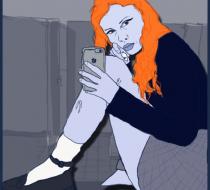Sad Girl Theory Favorite
During a moment when the facade of social media seems to be cracking, it’s easy to look to Instagram stars and wonder what’s real and what’s fake. Last month, Essena O’Neill, the Australian teenager who racked up more than half a million Instagram followers, quit Instagram after claiming that social media is “not real life.”
At first glance, you might scroll through artist Audrey Wollen’s Instagram and see another aspiring model-type. She’s tall, thin and beautiful, which could easily make for the beginnings of Insta-fame. Like O’Neill (and many young women on Instagram), her account is filled with selfies. If you take a closer look, though, you’ll see that she’s not your conventional Instagram “it” girl.
Wollen recently posted a painting of a nude young woman staring into a mirror, captioned with, “if u look at paintings of girls and replace each mirror w/ an iPhone in yr head, u will realize that nothing has ever been different.” Overnight, her historical take on selfies and girls’ narcissism got her seven dick pics, a slew of offensive messages, and a thousand new followers (her following is approximately 14,000 at last count).
When I spoke with Wollen at her Chinatown apartment in Los Angeles earlier this week, she said she guesses that the picture was posted on a porn site, accounting for the overnight spike in her Instagram audience. If followers are the main currency of Instagram, this could be cause for celebration, especially considering that the photosharing platform is Wollen’s primary medium for her digital artwork. Or the experience could be a reason to go the way of O’Neill and disappear from social media in an attempt to distance herself from the dark, ugly corners of the Internet.
But Wollen’s reaction, much like her art, was more nuanced and complex than either of these positions. There was no knee-jerk “#Fuckthehaters” response. Why? Because Wollen accepts the experience of girlhood (online and off) as a sad one.
At the center of Wollen’s art practice, girlhood and sadness are inextricably tied in what she has christened “Sad Girl Theory.” It’s the proposal that the sadness of girls should be witnessed and reframed as an act of political protest rather than a personal failure.
According to Wollen, girls being sad has been seen as passive, and therefore, dismissed from the history of activism. When you think about it, history, pop culture and mythology are full of “Sad Girls.” Wollen has previously named some of them — Judy Garland, Sylvia Plath, Lana Del Rey, Virginia Woolf, Judy Garland, Marilyn Monroe, Frida Kahlo, Brittany Murphy and Persephone.
The latter Sad Girl made a cameo of sorts in Wollen’s response to online slut-shamers, trolls and pervs. In a video on Instagram, she can be seen scooping out a pomegranate while talking about the number of seeds Persephone ate, an act that sealed her imprisonment in the underworld. The caption reads, “im interested but also not down. ann hirsch once said, ‘i believe that whenever you put your body online, in some way you are in conversation with porn’ and i would extend that to, whenever you exist, online or irl, as a girl. but if u followed this account just for that conversation im afraid yr in for a v bumpy ride ;)”
In my IRL conversation with Wollen, the artist discussed her Internet presence, shedding light on the murky performative space of social media we all inhabit.
On the “fakeness” of social media
While Instagram star O’Neill rejects the so-called “fakeness” of Instagram, Wollen doesn’t believe in such a strict binary of fake versus real. Clad in a custom black sweater adorned with white script reading “tragic queen,” the artist explained her perspective on the nature of truth on social media.
For her, performance isn’t necessarily negative and authenticity positive. As Wollen’s post of the 19th century painting pointed out, girls looking at themselves isn’t anything new and neither is the culture that places value based on a woman’s looks above anything else. When girls are expected to live up to the standards of their gender from birth, performance is inevitable and not something that should be punished.
“Everyone that exists online is part of a performance or is being performative,” she said. “I don’t think [a strict version] of authenticity exists — we are mediated by technology and language.”
Earlier in her career, her friends suggested to Wollen that she create a clear alter ego for simplicity’s sake as well as a sense of self-preservation. “But I like the idea of Audrey Wollen performing Audrey Wollen without the space of a clearly artificial title or stage,” she explained.







